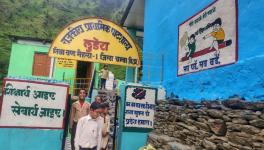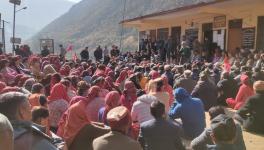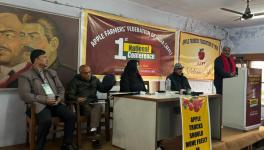Shongtong Karcham Story a Stark Precursor to Dilution of Environment Laws
Muck dumped along the Satluj River; no walls to protect it from rolling down in the river
The BJP-led Central Government is violating environmental laws with impunity. The amendments being brought to the EIA (Environmental Impact Assessment) law violate some of the fundamental principles of impact assessment, and are contrary to international protocols through which the EIA evolved.
The government is doing this at a time when it should be managing the COVID-19; the total number of cases from India has already surpassed one million. Instead, the BJP government is using this period as an opportunity to attack laws that were enacted after a prolonged struggle by the people – tribals and other environmental groups. Given the pandemic, people cannot come out in large numbers to register their protests. They have been raising their voice on social media however. The government did not even spare that, and has already disabled three websites which were campaigning against the amendments being brought to the EIA. The websites are www.letindiabreathe.in, www.fridayforfuture.in and www.thereisnoplanetb.in .
With the Centre making clear its intention to diminish the environmental ambit of measuring impact, the states – without the amendments being brought about – implementing diluted forms of environmental laws. One such case is the construction of a 450 MW Shongtong-Karcham hydro power project on the Satluj River in the tribal-dominated district of Kinnaur in Himachal Pradesh. This project is funded by the ADB (Asian Development Bank) and executed by HPPCL (Himachal Pradesh Power Corporation Limited) a subsidiary company of the state.
The Shongthom-Karcham uses run-of-the-river technology, using the potential difference of the river by diverting it to an underground tunnel. After a few kilometers water is released on to the turbines through a surge shaft, to generate electricity. The head race tunnel-as it is called, is nearly nine kms long. However, the digging of tunnel requires the extraction of a lot of muck which is then dumped into designated dumping sites. Likewise, for underground powerhouse, a large volume of muck is to be extracted and dumped in the open.
A truck dumping muck damaging the trees, along the Satluj River
Kinnaur, located in the steep mountain ranges of the Himalayas, does not have much open land to dump the muck. The path these projects then take is to create large retaining walls across the river, and dump the muck in those sites. This is dangerous and a flash flood could trigger devastation, but the practice, is invariably adopted in most of the hydro projects on the Satluj River; Nathpa Jhakri-1500 MW, Karcham Wangtoo-1,000 MW, Rampur-1,000 MW. In all of these projects, the walls can be seen on a drive from Rampur to the China border, all along the Satluj River.
According to the EIA report, of the total area required for the project 82.4% was forest land. Out of this area, a large space was designated as a muck dumping site, with some of these sites in open fields and some along the river side. However, the EIA has focused on not dumping along the river side. However, recent developments have once again proved that the EIA and actual reality are quite far removed from one another.
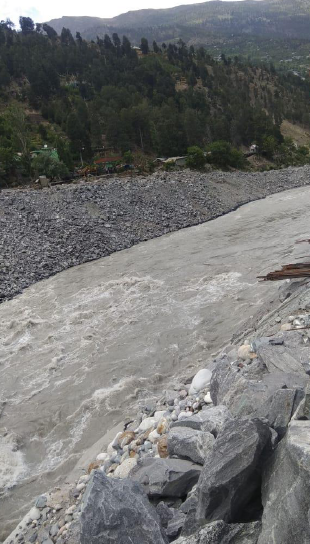
Muck dumped along the river
During the course of the construction of this project, the Government of India filed a petition in the High Court of Himachal Pradesh in the year 2013, seeking to stop the construction work of the Shongtong-Karcham hydro power project. The reason cited was the proximity of an Indian Army ammunition depot, which was just adjacent to the construction site. One of the reasons for stopping work was that the ammunition depot is just 40 kms from the Indo-Tibet border and of immense importance. The petition was allowed and the ammunition depot was supposed to be shifted to another village – Akpa, about 30 kms further upstream the Satluj River. Seven years have passed since High Court order which has not yet been implemented.
However, in 2019, one of the contractors in-charge of construction work sought permission from the commanding officer of the ammunition depot to allow dumping of the muck along the Satluj River. It is alleged that the commanding officer, in connivance with the construction company, allowed dumping on the land which de jure does not belong to them. The land was to be transferred back to the community, as it was owned by them before its acquisition. Besides, already a large area, nearly 50 hectares is allotted to the company to dump its muck. However, instead of using those sites, the construction company wants to dump it along the river, which is close to its sites.
muck dumping without any protection
In addition, the forest department was mobilised to create a sham report of the area where the muck was supposed to be dumped. There are contrary reports about it. One report states that there are no trees at the site, whereas another report points out that 339 trees will have to be cut just to provide muck dumping. Of these 339, a large number of trees belong to a rare species: Chilgoza. Pinus gerardiana – the botanical name for Chilgoza – is found at an altitude of between 1,800 metres and 3,350 metres above sea level, and bears a nutritious fruit called neoza. It is a near-threatened species found in the North-Western part of the Himalayas. The tribal folk of Kinnaur have been protecting it for ages. The trees, which are considered sacred to the tribal community, are now being cut just to provide a dumping site for the muck.
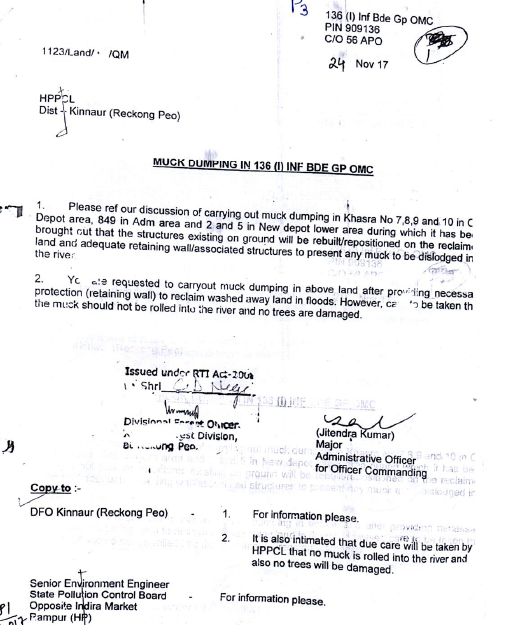
Order of the commanding officer allowing muck dumping
Local community leaders, led by C.D. Negi and Sohan Singh Mehta, moved the High Court in July this year and got an injunction against muck dumping along the Satluj River. The irony is that the state apparatus, including the state government and the district administration, has become a facilitator for such violations over the decades.
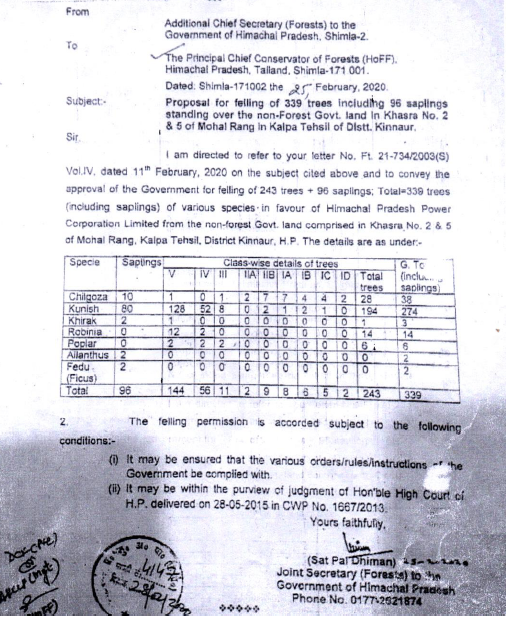
types of trees to be cut for muck dumping
The further dilution of the EIA will rob communities of their legitimate rights of at least intervening in the so-called development taking place their native places, which may actually rob them of their habitat and even their livelihoods!
The writer is former deputy mayor of Shimla. The views are personal.
Get the latest reports & analysis with people's perspective on Protests, movements & deep analytical videos, discussions of the current affairs in your Telegram app. Subscribe to NewsClick's Telegram channel & get Real-Time updates on stories, as they get published on our website.









